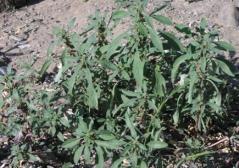
Amaranthus graceius / القطيف
Pigweed, Tumbleweed, Prostrate amaranth, prostrate pigweed
Dadh, Qutaif, Sindar, Shegra al santeen, Shaeb
Background
- Amaranthus is an annual herb, branched from the base, erect, decumbent or prostrate of the Amaranth family (Amaranthaceae)
- Widely dispersed in the drier northern part of the Region, tropical Africa, Europe and Asia.
- The plant is widespread in U.A.E especially in Coastal areas.
Part Used
Whole plant
Traditional and Medicinal Uses
The plant has edible leaves and is used as a vegetable, and also as a fodder for cattle. Traditional medicine practitioners use the plant externally as an anti-inflammatory. It has been used as/for:
|
Emollient |
Itchy rashes |
Mastitis |
Scorpion stings |
|
Oedmea |
Astringent |
Gargle |
Snake bites |
How Much Do We Know?
Some researches have been done on different Amaranthus species to evaluate their medicinal properties. Their claimed traditional medicinal uses for Helicobacter pylori, diarrhea, colic, bronchitis, and inflammation of the mouth and throat and to treat hypercholesterolemia remain uncertain.
What Do We Know About Safety?
- Likely safe when used orally in food amounts.
- Possibly safe when used as a medicine in the recommended doses for up to 3 weeks
Using Amaranthus by
Mouth
Cold tea
External
Gargle for mouth and throat and as a wash and poultice for skin .
Special Precautions & Warnings
Pregnancy and Breast feeding
Insufficient reliable information available; avoid using as medicine.
Keep in Mind
- Do not hesitate to speak with your health care provider before starting to use any supplements.
- Discuss potential benefits and risks, especially if you are suffering from any health problems.
